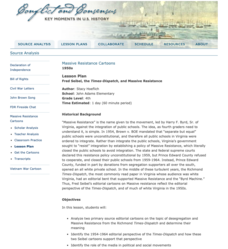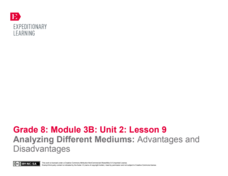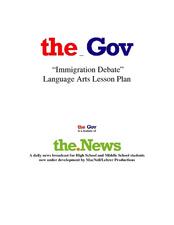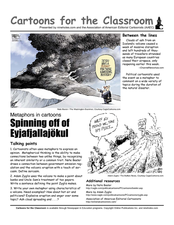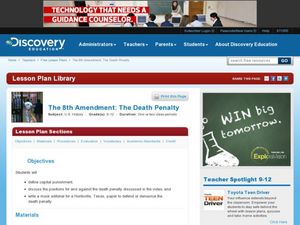Curated OER
Separate But Equal Opinions
Students examine the ways in which editorials and Op-Ed pieces respond to current events. They write editorials in response to news items from the New York Times.
Roy Rosenzweig Center for History and New Media
Fred Seibel, the Times-Dispatch, and Massive Resistance
A lesson challenges scholars to analyze editorial cartoons created by Fred Seibel, illustrator for the Times-Dispatch, during the Massive Resistance. A class discussion looking at today's editorial pages and Jim Crow Laws leads the...
Curated OER
A Durable Memento: Portraits by Augustus Washington
Young scholars read primary source newspaper articles from mid 19th century United States. The topics of the articles are slavery, abolitionism and colonization. Students are given several options for activities based on the readings.
The New York Times
I Don’t Think So: Writing Effective Counterarguments
When it comes to writing effective arguments, writers must do more than simply make a claim, counterarguments must be considered. Aspiring writers analyze counterarguments in editorials, and then learn how to write counterarguments in...
Curated OER
Cartoons for the Classroom: College as Concept
In this current events learning exercise, students analyze a political cartoon about the college application process and respond to 3 talking point questions.
Newseum
Reporting Part I: What Matters to Me
Young reporters have an opportunity to craft a news story about a topic that interests them. Class members brainstorm events and issues that affect them and possible sources of information. Individuals then select a topic, research it,...
EngageNY
Analyzing Different Mediums: Advantages and Disadvantages
How do authors play to people's moods? After briefly reviewing mood using a Conditional and Subjunctive Mood handout, learners practice identifying conditional and subjunctive sentences in the Montgomery Bus Boycott speech before reading...
Media Smarts
Tobacco Labels
Adolescents compare and assess the efficacy of tobacco product health warning labels from around the world. In groups, they invent warnings and create labels that would be effective for teens and children. Discussion covers advertising...
Curated OER
Re-Viewpoints From 2002
Students explore how editorials use various devices to convey a message to a reader. They select key news topics from 2002 and write their own editorials.
Curated OER
Propaganda Flyer
Fourth graders create a persuasive flyer to sway the opinion of the class on a controversial issue. They read assigned editorials representing the viewpoint that they must defend.
Curated OER
The Editorial
Students read several editorials such as those written by Upton Sinclair, Lincoln Steffens, and Ida Tarbell. They recognize the similarities between several editorials and summarize and outline the arguments presented in several editorials.
Curated OER
Digesting the News
Learners explore the editorial concepts, site designs and business models of online news digests. They propose detailed plans for Web sites that demonstrate their own areas of expertise.
Curated OER
Immigration Debate
The 2010 immigration bill passed in Arizona provides class members with an opportunity to examine various perspectives of the immigration debate by watching news videos, reading interview, editorials, and viewing images. Discussion...
SaveandInvest.org
Introduction to Earning Interest: Middle School
Does your bank pay you for allowing them to hold your money? Class members research three different ways they can earn money using money already in the bank. Topics include certificates of deposit, statement savings accounts, and...
National Endowment for the Humanities
A Defense of the Electoral College
Each presidential election year, the debate about the electoral college rages. Michael C. Maibach's "A Defense of the Electoral College" offers young political scientists an opportunity to examine a reasoned argument for why the...
Curated OER
Cartoons for the Classroom: Spinning off of Eyjafjallajökul
In this current events worksheet, students analyze a political cartoon about the eruption of Eyjafjallajökul and respond to 3 talking point questions.
Curated OER
Cartoons for the Classroom: Drawing on Everyday Themes
In this current events worksheet, students analyze a political cartoon about social issues and respond to 3 talking point questions.
Curated OER
Cartoons for the Classroom: Support Your Local Cartoonist
For this current events worksheet, students analyze a political cartoon based on a issue in Buffalo, NY and respond to 3 talking point questions.
Curated OER
Cartoons for the Classroom: Who Drew It Best?
In this current events worksheet, students analyze a political cartoon about the Cash for Clunkers Program and respond to 3 talking point questions.
Curated OER
Cartoons for the Classroom: B.D. Brings the War Home
In this current events worksheet, students analyze Doonesberry political cartoons and characters. Students respond to 6 talking point questions.
Curated OER
Cartoons for the Classroom: Taking a Stand
In this current events worksheet, students analyze political cartoons that feature the use of persuasion and propaganda. Students respond to 2 short answer questions.
Curated OER
Cartoons for the Classroom: When Women Toon In
In this current events worksheet, students analyze political cartoons about women by women. Students then respond to 2 short answer questions.
Curated OER
The 8th Amendment: The Death Penalty
Students take a closer look at the death penalty. For this U.S. government lesson, students watch a Discovery video about capital punishment in the United States and then compose letters to the editors of newspapers about their stance on...
Curated OER
Cartoons for the Classroom: Keep Current Through a Cartoonist's Commentary
In this current events worksheet, students analyze political cartoons about the Middle East and American domestic issues. Students respond to 4 talking point questions.



